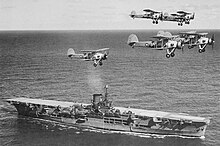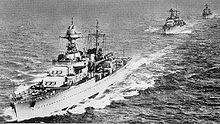Battle of Dakar
| Battle of Dakar | |||||||
|---|---|---|---|---|---|---|---|
| Part of World War II | |||||||
| |||||||
| Belligerents | |||||||
|
| |||||||
| Commanders and leaders | |||||||
|
|
| ||||||
| Strength | |||||||
|
2 battleships 5 cruisers 10 destroyers 1 aircraft carrier |
1 battleship 2 cruisers 4 destroyers 3 submarines coastal emplacements | ||||||
| Casualties and losses | |||||||
|
1 battleship crippled 1 battleship damaged 2 cruisers damaged 1 armed trawler sunk 6 torpedo planes lost |
1 destroyer grounded 2 submarines sunk 1 battleship damaged Danish freighter MS Tacoma sunk[1][2] | ||||||
The Battle of Dakar, also known as Operation Menace, was an unsuccessful attempt in September 1940 by the Allies to capture the strategic port of Dakar in French West Africa (modern-day Senegal). It was hoped that the success of the operation could overthrow the pro-German Vichy French administration in the colony, and be replaced by a Free French one under General Charles de Gaulle.
Background
At the beginning of World War II, the French fleet in the Mediterranean was to have countered the Italian Navy, thereby leaving the British Royal Navy free to concentrate on the German warships in the North Sea and Atlantic.
After the defeat of France and the conclusion of the armistice between France and Nazi Germany in June 1940, there was considerable confusion as to the allegiance of the various French colonies. Some, like Cameroun and French Equatorial Africa, joined the Free French, but others, including the North African colonies, French West Africa, Syria and Indochina, remained under Vichy control. The possibility that the French fleet might come under German control led the British to attack the French Fleet at Mers-el-Kebir on 3 July 1940. While the British had eliminated a potential threat, the attack discouraged other units from joining the Free French and Allies.

De Gaulle believed that he could persuade the French forces in Dakar to join the Allied cause. Much would be gained by this. Another Vichy French colony changing sides would have great political impact. Also the gold reserves of the Banque de France and the Polish government in exile were stored in Dakar; and the port of Dakar was far superior as a naval base to Freetown, Sierra Leone, which was the only Allied port in the area.[3]

Thus the Allies decided to send a task force to Dakar: an aircraft carrier (HMS Ark Royal), two battleships (HMS Resolution and HMS Barham), five cruisers, ten destroyers, and several transports carrying 8,000 troops. Their orders were to negotiate with the French governor for a peaceful occupation, but if this was unsuccessful, to take the city by force.
The Vichy forces present at Dakar included the unfinished battleship Richelieu, one of the most advanced warships in the French fleet, then about 95% complete. She had left Brest, France on 18 June, just before the Germans reached the port. Before the establishment of the Vichy government, HMS Hermes, a British aircraft carrier, had been operating with the French forces in Dakar. Once the Vichy regime was in power, however, Hermes left port but remained on watch, and was joined by the Australian heavy cruiser HMAS Australia. Aircraft from Hermes attacked Richelieu and had struck her once with a torpedo. The French ship was immobilized but was still able to function as a floating gun battery.
A force of three cruisers comprising (Gloire, Georges Leygues, and Montcalm) and three destroyers had left Toulon in southern France for Dakar just a few days earlier. Gloire was slowed by mechanical troubles and was intercepted by Australia which ordered the French cruiser to sail for Casablanca. The other two cruisers and the destroyers outran the pursuing Allied cruisers and reached Dakar safely. Three Vichy submarines and several lighter ships were also at Dakar.
Battle

On 23 September, the Fleet Air Arm dropped propaganda leaflets on the city of Dakar. Then Free French aircraft flew off Ark Royal and landed at the airport, but their crews were immediately taken prisoner. A boat with representatives of de Gaulle entered the port, but was fired upon. At 10:00, Vichy ships trying to leave the port were given warning shots from Australia. As the ships returned to port the coastal batteries opened fire on Australia. This led to an engagement between the British fleet and the batteries. In the afternoon Australia intercepted and fired on the Vichy destroyer L'Audacieux, setting her on fire and causing her to be beached.
Also in the afternoon, an attempt was made to set Free French troops ashore on a beach at Rufisque, to the south-east of Dakar. The attack failed due to fog and heavy fire from strong-points defending the beach.[4] General de Gaulle declared he did not want to "shed the blood of Frenchmen for Frenchmen" and called off the assault.
During the next two days, the Allied fleet continued to attack the coastal defences and the Vichy forces continued to defend them. Richelieu was hit by two 15-inch shells from Barham. On the second day of action, guns 7 and 8 (in turret number 2) of Richelieu failed on the first round. The following day, the crews were switched and main turret number 1 was used. Propellant charges reconditioned from charges left by the battleship Strasbourg in Dakar, during winter 1939, were used but these gave a significant reduction in range and caused problems of fire control. Over the two days Richelieu fired a total of 24 rounds. No hits were recorded by Richelieu.
During these engagements, two Vichy submarines (Persée and Ajax) were sunk, and the destroyer L'Audacieux damaged.
The Allied fleet also suffered damage: Resolution was torpedoed by the submarine Bévéziers, and Barham was hit by two shells from the coastal defence batteries which had been manned by crew from the No 1 main turret of Richelieu. Two cruisers were also damaged.
Overall, the Battle of Dakar did not go well for the Allies. The Vichy forces did not back down. Resolution was so heavily damaged she had to be towed to Cape Town. During most of this conflict, bombers of the Vichy French Air Force (Armée de l'Air de Vichy), based in North Africa, bombed the British base at Gibraltar. On 24 September about 50 aircraft dropped 150 bombs while on 25 September about 100 aircraft dropped 300 bombs on the harbour and dockyards. Most of the bombs missed. Some damage was caused, but few casualties were suffered. Only the British armed trawler HMT Stella Sirius was sunk by direct hits.[5] Finally, the Allies withdrew, leaving Dakar and French West Africa in Vichy hands.
Aftermath
The effects of the Allied failure were mostly political. De Gaulle had believed that he would be able to persuade the Vichy French at Dakar to change sides, but this turned out not to be the case, a result that damaged his standing among the Allies, and he had to content himself with the much less important and economically developed French Equatorial Africa as the main Free French territory for the time being. Even his success in the Battle of Gabon two months later did not wholly repair this damage.
English novelist Evelyn Waugh participated in the expedition as an officer in the Royal Marines. The battle has a role in his semi-autobiographical novel Men at Arms, which forms the first part of his Sword of Honour trilogy.
Order of battle
Allies

- Aircraft carrier: Ark Royal
- Battleships: Barham, Resolution
- Heavy cruisers: Australia, Cumberland, Devonshire
- Light cruisers: Dragon, Delhi
- Destroyers: Echo, Eclipse, Escapade, Faulknor, Foresight, Forester, Fortune, Fury, Griffin, Greyhound, Inglefield
- Escorts/patrol boats: Bridgewater, Commandant Dominé, Commandant Duboc, Président Houduce, Milford, Savorgnan de Brazza
- Merchant ships: four Free French and one British
- Transports: Westernland and Pennland (Dutch ocean liners), Sobieski (Polish ocean liner) and three more
- 101 Royal Marine Brigade
Vichy French

- Battleship: Richelieu
- Light cruisers: Georges Leygues, Montcalm
- Destroyers: L'Audacieux, Le Fantasque, Le Malin, Le Hardi
- Escorts/patrol boats: Calais, Commandant Rivière, D'Entrecasteaux, D'Iberville, Gazelle, Surprise
- Auxiliary cruisers: El Djezair, El Kantara, El Mansour, Schoelcher, Ville d'Oran
- Merchant ships: Porthos, Tacoma,[1][2] Sally Maersk (Danish freighter)
- Submarines: Ajax, Bévéziers, Persée
See also
References
- ^ a b Marcussen, Jørgen (4 December 2010). "Handels- og Søfartsmuseets Årbogsindeks". Maritim og historisk information (in Danish). Retrieved 20 January 2011.
- ^ a b Lindbæk, Lise (1969). Norway's new saga of the sea: the story of her merchant marine in World War II. Exposition Press, p. 204. ISBN
- ^ Lippman, David H., "Debacle at Dakar", WWII History, July 2011, pp. 48–55.
- ^ Churchill, Winston Spencer (1949). The Second World War: the Finest Hour. Houghton Mifflin Company, Boston. p. 489.
- ^ Naval-History.net
